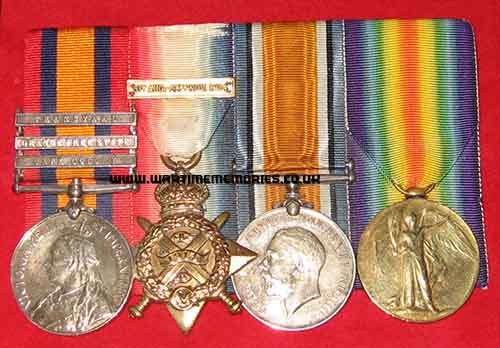Additions will be checked before being published on the website and where possible will be forwarded to the person who submitted the original entries. Your contact details will not be forwarded, but they can send a reply via this messaging system.
please scroll down to send a message
Pte. James Fay
British Army 2nd Battalion Leinster Regiment
from:Johnstown Garlowcross, Navan, Co Meath, Ireland
(d.12th Aug 1915)
James Fay was born 3rd April 1877, at Kilcairn, Johnstown, Navan, Co. Meath, to Patrick and Mary (nee Kelly) Fay. James grew up to work as a agricultural labourer on the family's small holding. The family story goes that James's father died at an early age, leaving the boys to help their mother to work on the small holding. Leaving his two brothers and mother with the farm, James joined the British Army in the early 1890's. According to records James joined the Prince of Wales's Leinster Regiment (Royal Canadians) at Navan, Co. Meath, becoming 6232 Pte James Fay, serving with the regiment's 1st battalion (attached 3rd) serving in the Boer War 1899-1902, receiving the Queen's South Africa service medal with the three state clasps, Orange Free State, Transvaal and Cape Colony. James served with the colours until around 1909, returning to Ireland as a reservist, he worked again on the small holding.
When war came to Europe in 1914, James, as a reservist, returned to the Colours of his old regiment, reporting for duty at Cork within 48 hours of war being declared.This time 6032 Pte James Fay found himself travelling to England and then to France with the 2nd Battalion Leinsters landing at St Nazaire, September 1914. James was wounded during the Leinsters' baptism of fire in Europe, at Premesques 20th October 1914. He was transported back to England spending time at a hospital in Bristol recovering from his wounds.
Returning to his regiment James found himself at Hooge, on the Menin Road just outside the famous town of Ypres, where the Leinsters met a terrible bombardment from the German artillery, where on 12 August 1915 he was killed along with 9 of his comrades. An account of his death can be found on page 68 of the book 'Stand To' A Diary of the Trenches, by Capt F C Hitchcock. James's family received the 'Death Plaque' and his medals, the 1914 Star with clasp, the British War Medal and the Victory Medal. James has no known grave but is remembered with honour on Panel 44 of the Menin Gate, Ypres.
As his great nephew, I was intrigued by this man, an Irishman who fought with the British Army, as I was born in England. I researched him as best as I could, sadly most of his records were destroyed in the bombing of the Second World War. During my research it was soon very apparent that due to his regiment being disbanded in 1922, that his memory, and the memory of his beloved regiment were passing into history and that there was no official body or organisation looking after their interests. So I set about reforming the Regimental Association for the Leinster Regiment, reforming 15 February 2003. I am now pleased to say that the Association is now thriving with many family members joining, and by joining they are bringing back the memory of the men who served.
Additional Information:
